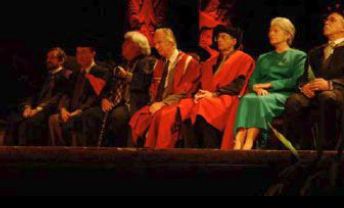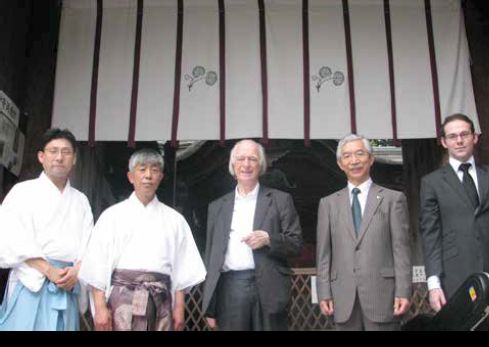
Physiology News Magazine
The international dimensions of the physiological sciences
The world has grown smaller. But the need for language skills, cultural understanding – and the International Union of Physiological Sciences – is undiminished.
Features
The international dimensions of the physiological sciences
The world has grown smaller. But the need for language skills, cultural understanding – and the International Union of Physiological Sciences – is undiminished.
Features
Denis Noble
President of the International Union of Physiological Sciences
Department of Physiology, Anatomy and Genetics, University of Oxford, UK
https://doi.org/10.36866/pn.91.18

The experience of being President of the International Union of Physiological Sciences is a great privilege, one that I have enjoyed for four years since the Congress in Kyoto in 2009. The previous President from the UK was Sir Andrew Huxley between 1986 and 1993: a very hard act to follow, with his sharp critical mind, and his phenomenal international reputation. One could not visit Russia without being reminded of the deep impression he had made by using Russian, or Japan with his knowledge of Japanese, or in German-speaking countries with German. As a young student at UCL many years ago I was greatly influenced not only by the extraordinary Nobel-prize winning work on the nerve impulse that he did with Alan Hodgkin, but also by his international and linguistic skills. I never imagined that I would one day be in his shoes! Or, indeed, those of his distinguished successors as president, particularly those with whom I served as Secretary-General: Masao Ito (Japan) and Ewald Weibel (Switzerland). They are all hard acts to follow.
Inspired by these thoughts of previous presidents, this article will focus on culture and international relations, and will then ask the question “Where is physiology going in the 21st century?”
Fifty years ago
My first recollection of IUPS goes back to Leiden in 1962, when a Congress was small enough to be held in a university. The days of grand convention centres, like that in Kyoto, situated in beautiful gardens and mountain slopes just on the edge of the medieval city, or the impressive Centre in Birmingham where the 2013 Congress is about to begin, had not yet arrived. In fact, Congresses were not very different from the annual meetings of the larger societies, such as The American Physiological Society, The Physiological Society (UK and Ireland), and some of the other large societies in the IUPS family (now around 50 nations). Last year, I enjoyed taking part in the meeting of the Scandinavian society held in Helsinki. That meeting also was fully international.
Back in 1962, we all had to be multi-lingual, or put up with sitting through talks we couldn’t understand. I recall talks at that Congress in English, French, German and Russian. Italian and Spanish were also used in earlier Congresses. Major international journals still published in languages other than English. The conversion of Pflüger’s Archiv für die gesamte Physiologie des Menschen und der Tiere, for example, into the European Journal of Physiology, was still in the future(*1). One of the important papers I needed to read for my PhD work was in French (Katz, 1949).
*1 Even today, one of the most frequent downloads from that journal is an article in German: Geller F (1941). Über die Blutgerinnung unter dem Einfluß von Gasen. Pflügers Arch 244, 687-695


The last fully multi-lingual IUPS Congress was Paris in 1977, where some of the lectures were in French (and not only by natural French speakers) with simultaneous translation. By the time of Vancouver 1986, however, only a very few abstracts appeared in French. Those days have gone. English has become the dominant international language of science, and the foreign language that young scientists should perhaps consider learning today is Chinese.
These changes pose major challenges for us, both in terms of culture and in terms of international relations.
Culture
Take culture first. You might think that the adoption of English as the international language of science has greatly simplified matters. That is true in the sense that no-one now has to decide what language to use in their presentations at international meetings as they did back in 1962. But it has also created its own complications. A form of international English has developed, with a much narrower range of vocabulary and idioms. Most users of English today are not from countries where it is the native tongue. Native English speakers often forget this. They may not realise that, most often, the easiest people to understand at Congresses are the non-native English users, precisely because they use a simplified language. The problems in understanding are created by the rich idioms and extensive vocabulary used by those of us for whom English is the native tongue. The international language that has developed is not really our own: it is just a small subset. When I lecture outside native English-speaking countries I try to do three things: slow down, speak clearly, and avoid too many strongly idiomatic expressions.
The second problem for native English speakers is the monoglot nature of our culture, with very few learning and even fewer using other languages. The losers in this case are the monoglots. It doesn’t really matter which other languages you can use. No-one can be master of, or even just dabble in, more than a few. Everyone knows that. What matters is the social advantage of acknowledging other cultures. It opens otherwise closed doors. During the Kyoto meeting, I used the limited Japanese that I have. It opened diplomatic doors at a very high level and enabled me to have unique experiences that I will treasure for the rest of my life. These experiences depended on others being able freely to converse in their own language without feeling that they were embarrassing me. My relatively limited knowledge gave them cultural freedom, from which I benefited myself in what I experienced and learnt.
I also recall the impact of the spectacular opening ceremony in Christchurch, New Zealand, 2001, where the fact that the whole of IUPS Council learned enough Maori to sing the required welcome at the Maori Powhiri (ceremonial welcome) impressed everyone, not just the Maori tribe that welcomed us. It is a rule of the Powhiri that everyone must use Maori until permitted to use another language.
International relations
Our Congress host this time, The Physiological Society, is no stranger to the international dimensions of our discipline. When it was founded in 1876, it entertained foreign guests from various parts of the world at its first scientific meeting. Its national meetings nowadays are like mini-international congresses. The same is true for the societies in the USA and in other parts of the world. A recent meeting in Suzhou in China was attended by a large enthusiastic audience of young Chinese, but it was also helped by scientific contributions and finance from many other societies around the world.
IUPS welcomes these developments. The future of physiology depends very much on the strength of the national societies, including the need to develop societies in parts of the world where they do not exist or are still relatively weak. The whole world benefits from the great strengths of the large national societies.
One might therefore wonder why we still need an organisation like IUPS. Have its original purposes now been taken over by the larger national societies?
Part of the answer is that there are international aspects of the work of IUPS that national societies are not so well placed to perform. A lot of IUPS’s work has focused recently on parts of the world that are or have been politically difficult, particularly for Western countries. Myanmar (Burma), Iran and North Korea are just a few examples where IUPS initiatives have been important, smoothing the way past diplomatic difficulties. Having a neutral body like IUPS allows the physiological community to function in ways that are not dissimilar to ways in which the UN and UN Agencies can achieve difficult negotiations beyond the capability of any national organisation acting alone. The relations with the International Council for Science (ICSU) are also important. Led by the initiatives of our Secretary-General, Walter Boron, IUPS has played a great role in joining with other biological science unions to increase our weight and influence in ICSU. One outcome is the joint Bio-Unions satellite meeting being organised after the Birmingham Congress. Another is that there will be delegates at the 2013 Congress from nations that have never participated before.
The second important aspect of the international work that IUPS does is rather more subtle. It derives from some of the points I have made concerning culture and languages. Even with the best of intentions, it is hard for a nationally based organisation to keep the sensitivities of the rest of the world in mind. One of the functions of the International Scientific Program Committee (formed equally by IUPS and the national host society) is precisely to ensure the various balances that are important in implementing the ICSU Principle of Universality to which IUPS (and through it, the various national society members) adheres. No discrimination on the basis of ethnic origin, religion, citizenship, language, political stance, gender or age is a goal towards which we have continually to strive, difficult though it may be to achieve it. The work of the women’s group within recent IUPS Congresses (Kyoto and Birmingham) shows what can be achieved and how important it is to work towards the goals. So do the initiatives IUPS has taken in Africa.
Many of these aspects of the work of IUPS involve quiet, patient diplomacy. Not much can be said about them unless they succeed.
Whither physiology?
Culture and diplomacy are important enough. But they would be of little avail if some of the depressing prognostications about the future of physiological science in the twentieth century had continued to be realised during the first decade of the twenty-first century.
Physiology was the gradual and unintended loser in a pincer movement that gathered momentum during the second half of the twentieth century (Noble, 2013). We were squeezed out from the central role in biology and medical science by developments in molecular biology on the one hand and evolutionary biology on the other.
Molecular biology held out the prospect of completely understanding organisms bottom-up. The dominant ideas included the ‘genetic program’ (Jacob and Monod, 1961), later to be described as the ‘book of life’ when the human genome project was launched, and the ‘central dogma of molecular biology’ (Crick, 1970). These ideas and metaphors strongly reinforced the trend within evolutionary biology to relegate the phenotype to the role of a transient carrier of the ‘real’ holders of the ‘secret of life’ – the genes (Dawkins, 1976, 2006). The version of neo-darwinism that became the Modern Synthesis (Huxley, 1942) went further. Genes became the real object of natural selection. Moreover, the source of variation was attributed to chance mutations. But, if the source of change was entirely random, physiology would have no role whatever in understanding the process. It would become important only at the stage of selection amongst the random variations. Any influence of the environment on the genome, other than retrospectively through the selection process, was also excluded.
But during the last ten years the world has moved on from these stringent (and, surprisingly enough, unproven) restrictions on how nature might behave. All the main assumptions of the Modern Synthesis need to be modified or abandoned (Pigliucci and Müller, 2010). Even a cursory listing of the titles of some recent articles shows new experiments breaking the rules of that synthesis, sometimes in quite astonishing ways: ‘Rocking the foundations of molecular genetics’ (Mattick, 2012); ‘A unified approach to the evolutionary consequences of genetic and non-genetic inheritance’ (Day and Bonduriansky, 2011); ‘Finding the missing heritability of complex diseases’ (Manolio, Collins et al. 2009); ‘Paramutation: from maize to mice’ (Chandler, 2007); ‘Nuclear RNAi maintains heritable gene silencing in Caenorhabditis elegans’ (Burton, Burkhart et al. 2011); ‘Epigenetic inheritance and the missing heritability problem’ (Slatkin, 2009).
To quote from Mattick’s recent PNAS article:
“The available evidence not only suggests an intimate interplay between genetic and epigenetic inheritance, but also that this interplay may involve communication between the soma and the germline. This idea contravenes the so-called Weismann barrier, sometimes referred to as Biology’s Second Law, which is based on flimsy evidence and a desire to distance Darwinian evolution from Lamarckian inheritance at the time of the Modern Evolutionary Synthesis. However, the belief that the soma and germline do not communicate is patently incorrect.”
This passage would have been unthinkable in such a prestigious journal 10 years ago. The article on which it comments demonstrates a trans-generational epigenetic effect forbidden by the Modern Synthesis (Nelson, Heaney et al. 2012). We are at the threshold of a phenomenal development. It is such a radical change that many consider that a complete reformulation of evolutionary theory is required. The remarkable fact is that much of the deconstruction of the central dogma and of the Modern Synthesis has come from molecular biology itself (Shapiro, 2011).
It may be too early to see where exactly all this is leading. But the implications for a reintegration of physiology with evolutionary biology are already clear. What seemed impossible a decade ago is now a reality. The opportunities for physiological science are immense, which is why I have chosen to devote the President’s Lecture at the Birmingham Congress to this topic (Noble, 2013). The true international dimension of our discipline is that it is set to make one of the most spectacular comebacks known anywhere on earth. All over the world, we are where the action will be during the rest of the twenty-first century.

References
Burton NO, Burkhart KB et al. (2011). Nuclear RNAi maintains heritable gene silencing in Caenorhabditis elegans. PNAS 108(49), 19683-19688.
Chandler VL (2007). Paramutation: From maize to mice. Cell 128(4), 641-645.
Crick FHC (1970). Central dogma of molecular biology. Nature 227, 561-563.
Dawkins R (1976, 2006). The Selfish Gene. Oxford, Oxford University Press.
Day T, Bonduriansky R (2011). A unified approach to the evolutionary consequences of genetic and nongenetic inheritance. Am Nat 178, E18-E36.
Graddol D (1997). The Future of English? London, British Council.
Huxley JS (1942). Evolution: the modern synthesis. London, Allen & Unwin.
Jacob F, Monod J (1961). Genetic regulatory mechanisms in the synthesis of proteins. J Mol Biol 3, 318-356.
Katz B (1949). Les constantes électriques de la membrane du muscle. Arch Sci Physiol (Paris) 3, 285-299.
Manolio TA, Collins FS et al. (2009). Finding the missing heritability of complex diseases. Nature 461(7265), 747-753.
Mattick JS (2012). Rocking the foundations of molecular genetics. PNAS 109, 16400-16401.
Nelson VR, Heaney JD et al. (2012). Transgenerational epigenetic effects of Apobec1 deficiency on testicular germ cell tumor susceptibility and embryonic viability. PNAS 109, E2766–E2773.
Noble D (2013). More on Physiology without Borders. Physiology 28, 2-3.
Noble D (2013). Physiology is rocking the foundations of evolutionary biology. Exp Physiol, doi: 10.1113/expphysiol.2012.071134
Pigliucci M, Müller GB (2010). Evolution: The extended synthesis. Cambridge, Mass, MIT Press.
Shapiro JA (2011). Evolution: a view from the 21st century. Upper Saddle River, NJ, Pearson Education Inc.
Slatkin M (2009). Epigenetic inheritance and the missing heritability problem. Genetics 182(3), 845-850.
